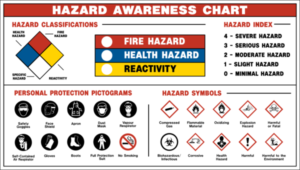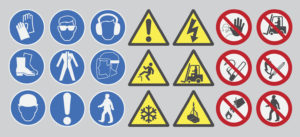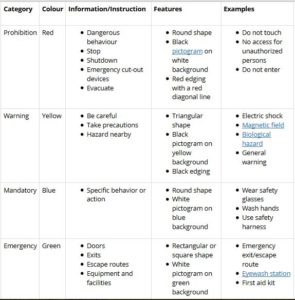Canada’s Workplace Hazardous Materials Information System (WHMIS) and OSHA’s Hazard Communication Standard (HCS) align with and draw on the Globally Harmonized System of Classification and Labeling of Chemicals (GHS). Using this international system helps ensure consistency in the classification of chemicals and the communication of hazard information on labels and safety data sheets.
The system uses pictograms on labels to alert users of the chemical hazards they may be exposed to. Every symbol consists of a black pictogram on a white background, framed by a red border. There are nine different pictograms, each representing a different chemical hazard classification.
Health Hazard

- Carcinogen
- Mutagenicity
- Reproductive toxicity
- Respiratory sensitizer
- Target organ toxicity
- Aspiration toxicity
Flame

- Flammables
- Pyrophorics
- Self-heating
- Emits flammable gas
- Self-reactives
- Organic peroxides
Exclamation Mark

- Irritant (skin and eye)
- Skin sensitizer
- Acute toxicity (harmful)
- Narcotic effects
- Respiratory tract irritant
- Hazardous to ozone layer
Gas Cylinder

Corrosion

- Skin corrosion/burns
- Eye damage
- Corrosive to metals
Exploding Bomb

- Explosives
- Self-reactives
- Organic peroxides
Flame Over Circle

Environment

Skull and Crossbones

Which Signs and Symbols Are Appropriate for Your Workplace?
To know what symbols should be in your workplace, you’ll need to perform a comprehensive risk assessment. Assessments should be conducted for each activity and at each designated workspace to make sure you identify all potential hazards. Once you have that information, you’ll know where workers will need safety reminders.
Note, however, that you might want to make sure the signs can be moved. After a while, workers become so familiar with the safety signs that they start to just be part of the background. To avoid this “sign blindness,” safety experts recommend switching up the location of your signs every so often to keep the safety message top of mind (learn more in In Sight, In Mind: Reinforcing Safety Policies and Procedures).
Conclusion
Safety signs and symbols exist to make identifying potential hazards easier. Keep things simple by spreading signs out within an area to avoid clustering them. Too many signs crammed together overwhelms workers with information and makes it less likely that they pay careful attention.
And remember that safety signs only work if everyone understands them. Conduct regular refresher training to ensure that every worker is familiar with the symbols and their meanings.











